

|
| DEUTSCHLAND | GERMANY |
| Bundesland: Sachsen-Anhalt | Saxony-Anhalt |
| Landkreis: Mansfeld-Südharz |
Lutherstadt Eisleben is situated at an elevation of 114 m in the southern foothills of the Harz mountains in the Mansfelder Land district of Germany's state of Sachsen-Anhalt.
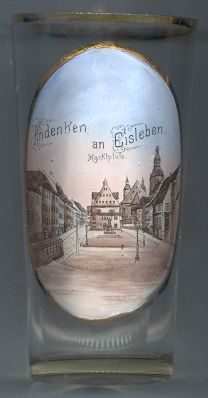 The earliest settlements in this place seemed to have been founded in the 3rd to 6th centuries AD.
A moated castle was founded in the 9th/10th century.
The first written mention of Eisleben is found in a document of 994 AD when the German King Otto III (996 Holy Roman Emperor)
granted Eisleben the privileges of a market town. The privileges were confirmed in 1045 by King Heinrich III (1046 Holy Roman Emperor).
From 1081 until 1083 Count Hermann of Salm-Luxembourg resided in the castle of Eisleben as antiking to King Heinrich IV (1083 Holy Roman Emperor).
From 1121 until 1809 Eisleben was governed by a bailiff of the counts of Mansfeld.
Fortifications were built in the mid-12th century, and in 1180 Eisleben for the first time was mentioned
as a 'civitas', a town. Around 1190 it also became the seat of an archdean of the bishopric of Halberstadt.
Copper mining had started around 1200, and in 1215 the counts of Mansfeld obtained the mining privilege
which was confirmed in 1364.
The earliest settlements in this place seemed to have been founded in the 3rd to 6th centuries AD.
A moated castle was founded in the 9th/10th century.
The first written mention of Eisleben is found in a document of 994 AD when the German King Otto III (996 Holy Roman Emperor)
granted Eisleben the privileges of a market town. The privileges were confirmed in 1045 by King Heinrich III (1046 Holy Roman Emperor).
From 1081 until 1083 Count Hermann of Salm-Luxembourg resided in the castle of Eisleben as antiking to King Heinrich IV (1083 Holy Roman Emperor).
From 1121 until 1809 Eisleben was governed by a bailiff of the counts of Mansfeld.
Fortifications were built in the mid-12th century, and in 1180 Eisleben for the first time was mentioned
as a 'civitas', a town. Around 1190 it also became the seat of an archdean of the bishopric of Halberstadt.
Copper mining had started around 1200, and in 1215 the counts of Mansfeld obtained the mining privilege
which was confirmed in 1364.
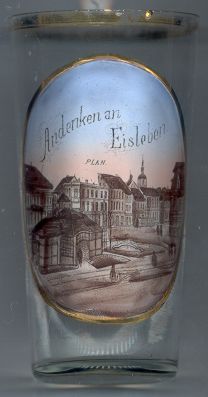 On the 10th of November 1483 the reformer Martin Luther was born in Eisleben.
In 1498 the old town was completely destroyed by a fire. Between 1480 and 1520
the town was rebuilt including several village that until then were located outside the old fortifications.
In parallel, the 'new town' was created from 1511 onward according to a regular ground plan.
In 1525 the town converted to the Protestant faith and with the death in 1540 of the last Catholic count,
the whole county became Protestant. Luther returned to Eisleben in 1546 to arbitrate
in a dispute between the old and new town. Three weeks later Martin Luther died here.
In 1570 the counts of Mansfeld-Vorderort lost their possessions in Eisleben beacuse of their debts.
three fifth and the entire mining privilege were obtained by the Electors of Saxony, the remaining
two fifth were obtained by Magdeburg.
Mining was almost discontinued in the late 16th and early 17th century.
In 1601 most of the town was again completely
destroyed by a fire, in 1626 about 3,000 inhabitants fell victim to the Plague.
The Thirty Years' War (1618–1648) also caused severe hardships as the town was repeatedly occupied by
both Imperial and Swedish troops. In 1671 the Elector of Saxony, Johann Georg II, allowed the
industrialisation of mining in the Mansfeld county. Seven mining unions were founded between 1673 and 1723.
However, the Plague returned in 1681, and a large fire in 1689 again destroyed large parts of the town,
this time also the birth house of Luther.
On the 10th of November 1483 the reformer Martin Luther was born in Eisleben.
In 1498 the old town was completely destroyed by a fire. Between 1480 and 1520
the town was rebuilt including several village that until then were located outside the old fortifications.
In parallel, the 'new town' was created from 1511 onward according to a regular ground plan.
In 1525 the town converted to the Protestant faith and with the death in 1540 of the last Catholic count,
the whole county became Protestant. Luther returned to Eisleben in 1546 to arbitrate
in a dispute between the old and new town. Three weeks later Martin Luther died here.
In 1570 the counts of Mansfeld-Vorderort lost their possessions in Eisleben beacuse of their debts.
three fifth and the entire mining privilege were obtained by the Electors of Saxony, the remaining
two fifth were obtained by Magdeburg.
Mining was almost discontinued in the late 16th and early 17th century.
In 1601 most of the town was again completely
destroyed by a fire, in 1626 about 3,000 inhabitants fell victim to the Plague.
The Thirty Years' War (1618–1648) also caused severe hardships as the town was repeatedly occupied by
both Imperial and Swedish troops. In 1671 the Elector of Saxony, Johann Georg II, allowed the
industrialisation of mining in the Mansfeld county. Seven mining unions were founded between 1673 and 1723.
However, the Plague returned in 1681, and a large fire in 1689 again destroyed large parts of the town,
this time also the birth house of Luther.
During the 18th century Eisleben was occupied by the Swedes during the Nordic War (1701–1706) and by Prussia during the Seven Years' War (1756–1763). Between 1806 and 1814 the Mansfeld county was part of the Napoleonic Kingdom of Westphalia. During this period, in 1806, the old town and the new town were united. In 1815, after the Congress of Vienna, Eisleben became part of Prussia. In 1816 the administrative county was divided between the Mansfeld lake district (Eisleben) and the Mansfeld mountain district (Mansfeld). Eisleben was made an independent city in 1908 and remained so until 1950. In 1946 the name of the town was officially changed to Lutherstadt Eisleben. The two administrative districts and the city of Eisleben were again united to the administrative district Eisleben (Mansfeld), but again divided in 1952 between the districts Eisleben and Hettstedt. Mining in the Mansfeld area was finally discontinued in 1963–1969. Since the reunification of Germany in 1990 Eisleben is part of Germany's state of Sachsen-Anhalt. The districts of Eisleben and Hettstedt were again united to the district Mansfelder Land in 1994 and Eisfeld was chosen as the seat of the district administration. In 1996 the Luther memorial places in Eisleben and Wittenberg were listed by the UNESCO as a World Cultural Heritage (see also list of other UNESCO heritage sites). On the 1st of July the districts Mansfelder Land and Sangerhausen were merged. The administration of the new district Mansfeld-Südharz is in Sangerhausen.
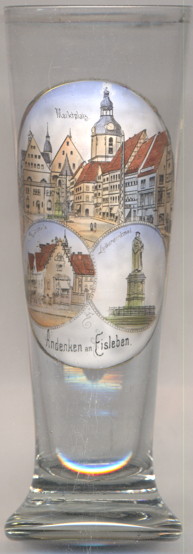
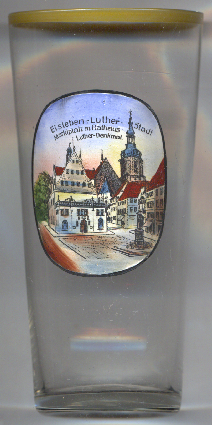
The pictures on glasses no. 1870 [top left], no. 3475 [left: top picture] and
no. 4889 [right] show views of the  Marktplatz
Marktplatz
The  Rathaus
Rathaus
In the right background of the pictures one can
see  St. Andreas
St. Andreas
The picture on glass no. 1871 [top right] shows the
 Plan
Plan
The  Luther monument [left, no. 3475: bottom right picture]
was created in 1883 by the sculptor Rudolf Siemering for the celebration of Martin Luther's 500th anniversary.
Luther monument [left, no. 3475: bottom right picture]
was created in 1883 by the sculptor Rudolf Siemering for the celebration of Martin Luther's 500th anniversary.
[https://de.wikipedia.org/wiki/Lutherdenkmal]
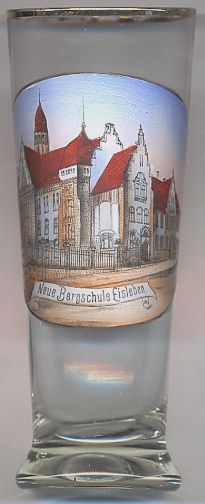
The  Neue Bergschule ('new montanistic academy') [far left, no. 3475: bottom left picture;
and near left, no. 2457],
located in Geiststraße 2, was built in 1901/1903 in historicist renaissance revival style.
The "Bergschule" (montanistic school) was founded by the government of the Electorate of Saxony in 1798 as a school for officers
in the mines of the southern Harz foothills. Education had been done on an occasional basis already since 1719.
The new school not offered a montanistic education on a regular basis. It followed the example of the Bergakademie of
Freiberg, the world's oldest montanistic academy (founded in 1765).
During the Napoleonic wars the school had to close. After the Congress of Vienna (1815)
the county of Mansfeld was incorporated into Prussia (province Saxony). The school was reopened in 1817 and was at first
located in the former St. Catherine's hospital.
In 1903, the Bergschule moved to a new building (depicted on glass no. 2457).
After World War II, the building was used by the Soviet Army until 1948.
In 1968 the Bergschule was reorganized and became the "Ingenieurschule Eisleben", an academy for
engineers in electro-technics and engine construction. At the same time, the education in mining-related subjects was phased out.
The last mining engineers were graduated in 1971. In 1991 the school became a vocational school for technology and economics.
Neue Bergschule ('new montanistic academy') [far left, no. 3475: bottom left picture;
and near left, no. 2457],
located in Geiststraße 2, was built in 1901/1903 in historicist renaissance revival style.
The "Bergschule" (montanistic school) was founded by the government of the Electorate of Saxony in 1798 as a school for officers
in the mines of the southern Harz foothills. Education had been done on an occasional basis already since 1719.
The new school not offered a montanistic education on a regular basis. It followed the example of the Bergakademie of
Freiberg, the world's oldest montanistic academy (founded in 1765).
During the Napoleonic wars the school had to close. After the Congress of Vienna (1815)
the county of Mansfeld was incorporated into Prussia (province Saxony). The school was reopened in 1817 and was at first
located in the former St. Catherine's hospital.
In 1903, the Bergschule moved to a new building (depicted on glass no. 2457).
After World War II, the building was used by the Soviet Army until 1948.
In 1968 the Bergschule was reorganized and became the "Ingenieurschule Eisleben", an academy for
engineers in electro-technics and engine construction. At the same time, the education in mining-related subjects was phased out.
The last mining engineers were graduated in 1971. In 1991 the school became a vocational school for technology and economics.
![[scale]](lineal.jpg)